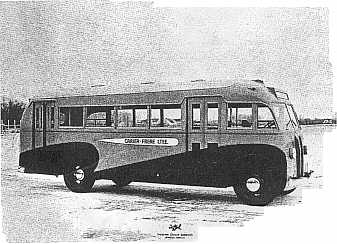
| The model 300 was built in two versions. There were 14 produced as bodies only, for various economy-model chassis (mostly Chevrolet) and then 231 complete buses were built, usually with Chevrolet engines. Included among the complete buses was this unusual two-door version built in 1941 for Carier & Frere of Shawinigan Falls, Quebec. |
|
The Age of the Integral Bus FitzJohn's last bus body was a model 625 intercity job mounted on a White 1012 chassis and delivered to White as a demonstrator in March of 1940. Meanwhile, under the leadership of James J. St. Croix, redesigned versions of the 300 and 325 appeared as complete integral buses under the same model designations. Mr. St. Croix had joined FitzJohn after being employed for some years as a designer for Yellow Coach, where he had a hand in the design of Greyhound's model 719 Super Coach. His influence on FrtzJohn, exercised .mainly in the late 19301s, was to be felt uritil the end of the companyls existence. With the change to integral buses came the second change of name for the company within four years--to FitzJohn Coach Co. The name Fi tzJohn Body Co. had been adopted in 1935.
Model 300 continued to be the company's only offering in the city transit field for some years. But FitzJohn had found a se.cure place as a supplier of lightweight, economical intercity buses. Model 325 ~s discontinued in 1940 and replaced by two new designs by St. Croix--the 500 (called the DurRliner) and the 600 (the well-known
| Like the 300, the parlor model 325 was built both for mounting on chassis and as a complete integral bus. Cherry Transit Lines of Green Bay, Wisc., took delivery of this 325 on a Chevrolet chassis in August 1937. |
|
13